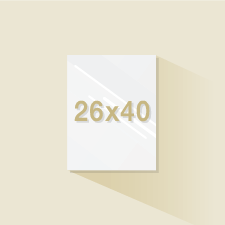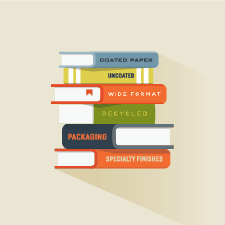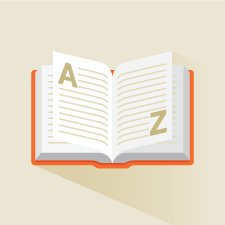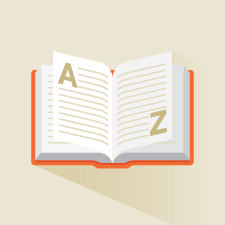We use cookies to make your experience better. To comply with the new e-Privacy directive, we need to ask for your consent to set the cookies. Learn more.
We are the paper people
We represent more than 30 mills and manufacturers and carry everything from copy paper to coated stocks, recycled grades to writing paper. So whether you’re a printer, an ad agency or design studio, a business or corporation, you can count on us for all your paper needs.
We believe that any company that just sells paper doesn’t do enough. That’s why we sponsor special programs like our popular Paper School and have outlined the basics of paper right here. We help customers learn more about the characteristics of various papers, enabling them to choose the products that best meet their needs. We also maintain a large, well-stocked sample room and can quickly produce even the most complex sample dummy in any grade of paper, so you can experience just how your finished piece will look and feel.
Our educational opportunities are extended to our employees as well as our clients. Each of our representatives undergo extensive ongoing training to keep on top of the industry. You can count on us to be the most knowledgeable Paper People in town.








Help Section


Glossary
Paper terminology can be confusing! We've curated a list of the most-used terms to help you identify the perfect paper for your project. As always, please reach out by chatting with us (bottom left corner of this page) or contact us via email with any questions.
Absorption: draining of ink vehicle into paper, leaving the pigment on the surface
Accordion Fold: folded two or more times in a parallel direction
Acid Papers: papers manufactured to a pH above 7.0 using clay as the primary filler & alum rosin sizing. Because of the acidity, these papers are not as longlasting as alkaline (acid-free) papers
Additive Litho Plate: something must be added to the plate surface in order to develop the image
Adhesives: glues that bind coated paper ingredients together
Air Knife Coating: coating method wherein a thin blade of air is used to apply coating uniformly
Alkaline Papers: permanent papers (pH 7.5 - 8.2)
Alum: aluminum sulfate, an acid salt
Anodized: grained
Anti-Offset Spray: powder which creates a gap between sheets of paper
Antique Finish: toothy, open texture; hand-crafted look
Applicator Roll Streaks: streaks on coated paper caused by interrupted coating flow
Archival: containing no groundwood or optical brighteners; neutral pH or alkaline pH
Art Prep: steps involved in preparing art and copy
Back Trimming: cutting all edges of a sheet with the back (non-beveled) edge of the trimming knife
Backing Up: printing the opposite side of the sheet after the first has been printed
Backtrap Mottle: in multicolor printing, unset ink lifts onto the next printing blanket, causing a mottling of color
Barrel Fold: folded two or more times in the same direction (wraparound)
Basic Size: a standard predetermined size for a particular type of paper
Basis Weight Scale: instrument used to measure basis weight
Basis Weight: the weight in pounds of a predetermined number of sheets of a specific size
Binders: additives that increase strength, hardness; decreased surface fuzz
Binding: operations necessary for turning printed sheets into books, magazines, catalogs, etc
Black Liquor: spent cooking chemicals from the pulping process
Blade Coating: coating method which results in a very smooth surface
Blanket Smash: a compressed area on a blanket due to excessive pressure
Blanket Cylinder: carries the rubber blanket, which transfers the image to the paper
Blanket: intermediate between the plate and paper
Blanks and Boards: paperboards (over .012˝ thickness), produced on cylinder machines
Bleaching: stain removal to improve whiteness of pulp
Bleed: printed image extends past the trim edge of a sheet or page
Blistering: oval or round bubbles visible on coated web papers
Blocking: cementing together of printed sheets
Body: consistency; stiffness or softness
Bond: writing paper
Bowed Edges: convex or concave edges caused by a dull knife or uneven cutting pressure
Brightness: measurement of diffuse light reflection from a paper surface
Bristol: stiff, heavy papers characterized by bulk and strength; includes index and printing bristols
Brownstock Washing: in chemical pulping, separates fibers after cooking
Buckle: wave-like distortions near the spine of a book caused when signatures pick up moisture from air, glue, etc. (or) paper defect caused by hard calendering on one edge, making the paper thinner and longer which causes it to buckle when wound on a roll
Bursting Strength: the amount of uniformly applied pressure required to rupture a sheet of paper
C : hundred
Calcium Carbonate : primary filler used in alkaline paper making; limestone or chalk
Calender Cut : a cut occurring during the calendering process
Calender Spot : spot on paper caused by sticking to the calender roll
Calendering : mechanical treatment of a coated sheet which imparts smoothness and gloss; passing a sheet of paper through a series of alternating steel and cotton rolls in order to smooth the surface and control bulk
Caliper : thickness, bulk (measured in mils - thousandths of an inch)
“Can” Tack : ink tack rating marked on the can
Capsule Damage : unwanted release
Carbonless Papers : chemically coated so that duplicate copies can be produced without the use of carbons
Cast Coated : coated paper characterized by a highly polished, mirror-like surface and exceptional smoothness
Cast Coating : pressing a wet coated surface against a heated polished chromeplated dryer
Catalog Producer: printer of retail catalogs, newspaper inserts
CB (Coated Back) : top sheet in a carbonless form
CD-ROM : compact disk with read-only memory
Center Spread : a signature with its two center pages constituting the center of a magazine
CF (Coated Front) : receiver sheet in a carbonless form
CFB (Coated Front & Back) : intermediate sheets in a carbonless form
Chalking : printed image; can be easily rubbed off after the ink dries
Champion Doctor : method of coating paper
Chemi-Thermomechanical Pulp (CTMP) : a mechanical pulping process where chemicals and heat is added to soften lignin
Chemical Pulping : pulping process in which chips are cooked in a pressurized digester
Chemimechanical Pulping : combination of chemical and mechanical pulping processes; produces pulp high in strength and yield
Chill Roll : in web printing, sets the ink and cools the web CIC (common impression cylinder)
Clay : filler pigment used in coating paper
Coated Paper : paper composed of a base sheet covered on one or both sides with a finishing layer
Coated Groundwood : containing 10% or more mechanical pulp
Coated Blade Scratch : fine identation in the coating surface
Coated Free Sheet : containing 10% or less groundwood pulp
Coating Lump : hard, irregualrly shaped deposit of undispersed clay loosely embedded in the paper surface
Coating Scale : dried coating embedded in the sheet; deposits on blanket or plate
Coating Splash : wet coating splashed on a sheet of paper
Coating Streak : uneven distribution of coating
Cockling : tub sizing followed by drying
Collating : organizing parts of a job into a predetermined order
Color Copier : xerographic equipment that produces color prints
Color Correction : any method used to improve color rendition
Color Separation : dividing color originals into printing color components
Color Scanner : electronic device used in the making of color and tone-corrected separation of images
Commercial Printer : printer who has the capability to print a broad range of products for a varied market
Compressible Blanket : blanket containing air bubbles for smash resistance
Contact Screen : halftone screen
Contamination : surface dirt
Continuous Tone : image that contains gradient tones from black to white
Conventional Gummed Paper : wet gummed; glue is shiny in appearance
Cotton Content Bond : watermarked writing paper containing cotton fiber
Crash Sequence : carbonless set arranged in proper functional order
Creep : a problem experienced in thick saddle-stitched booklets which results in a page size difference from folding and wrapping around of the thick signatures
Cross Grain : the direction of paper at right angles to the machine direction
Crows Feet : mark found on cast coated paper where drum speed is increased with no change in coating viscosity
Curl : tendency of paper to bend rather than lie flat
Cutter Wrinkle : crease or fold caused by faulty cutting of paper
CWT : per hundred pounds
Cylinder Machine : papermaking machine which uses vats or cylinders to make multi-ply papers
Dampering System (Fountain System) : a system of rollers which wet all areas of the offset printing plate
Dandy Roll : a roll incorporating raised characters which are impressed on paper to form a watermark
Dandy Mark : surface dulling caused by uneven dandy roll pressure
Dandy Mark : surface dulling caused by uneven dandy roll pressure
Dandy Lick : dandy roll filled area; causes glazed spots on paper surface
Debarking : removal of bark from logs
Deckle Edge : untrimmed, feathery edge formed by straps and water or air jets
Deckle : width of paper web; maximum trim
De-inking : process of removing ink and contaminants from waste paper
Delamination : peeling apart or separating from within
Dennison Wax Test : method that measures surface strength of paper
Densitometer : instrument used to measure and control the density of ink; in photography, measures density of photographic images or colors
Density : weight per unit volume
Diffuse Reflection : scattered reflected light; determines brightness
Digester : a stage in the papermaking process where unbleached pulp is cooked under pressure
Digital Camera : a camera that produces a direct digital image without the use of a scanner or film
Digital Proofing : electronic color proofing
Dimensional Stability : ability to maintain constant dimensions
Direct : purchase from the mill manufacturer
Directionality : the direction in which the fibers lie
Dispersion : in de-inking, kneading remaining ink particles until they are invisible
Doctor Blade : a device, which wipes excess ink off a printing cylinder; commonly found on Gravure presses
Docutech : xerographic equipment used for high-speed production of short-run manuals, books, etc.
Dot Gain : dots print larger than they should, causing darker tones and stronger colors
Dot Etching : alteration of halftone dot size for color correction purposes
Dot : single component of a printed halftone image
Drum Pick : a void in the surface of a cast coated paper caused by excessive drum temperature
Dry Trapping : printing one ink film over another that has already dried
Drying Section : the area of the paper machine where moisture content is reduced to the desired level
Dull Coated : little or no gloss; “sheen” rather than “shine”
Duotone : two-color halftone
Duplex : two sheets of paper stock laminated together
Duplexing : two-sided photocopying
Duplicator Paper : paper with a smooth, tight surface to be used on a spirit duplicating machine
Dusting : coating dust or filler, which builds on the blanket in the non-image area
Are you ready for Paper School?
While paper may seem relatively simple, there is a true science to selecting the right paper when developing project specifications. An uninformed decision can result in unhappy clients, unreadable text and unimpressed customers.
At the Clampitt Paper School, attendees learn the basics of paper manufacturing and economics, the differences between coated and uncoated stocks, industry terminology and much more. Classes are provided every quarter in Dallas and each session lasts only a few hours. (We’ll even provide lunch).

